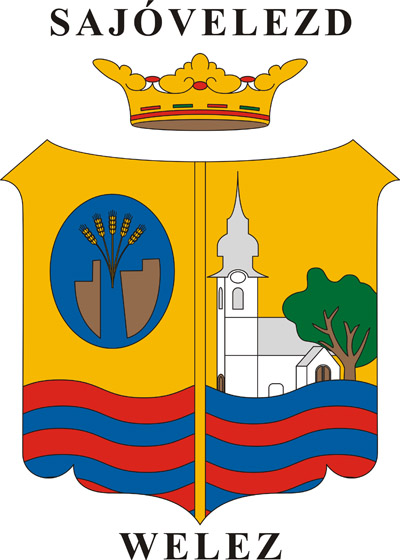
(Borsod-Abaúj-Zemplén megye)
A történelmi múltunk helyi nagy alakja Tomori Pál. A Tomori címer különleges formájú pajzs koronával, egyedi címerállattal. E címernek egyes elemeit használta fel a múltat megjelenítve.
A kettéosztott Tomori féle pajzsformában a régi pecsétnyomat elemei kerültek, a másik felébe pedig a községünk szintén történelmi jelképének számító református templom került.
A velezdiek életét két szín határozza meg: a barna, vagyis a föld szeretete; és a kék, a Sajó vize.
A folyó vonala a címer alsó részén osztja meg a formát, ahol a hullámvonal két völgye is szimbolikus jelentésű: idegen erők pusztításait és a hatalmas tűzvészt jelképezi, amelyek a múltban, a faluban pusztítottak. De bármi is történt újra és újra visszatért a lakosság, ezért a címer fennmaradó része sárga lett: a Nap a kalász, vagyis az élet színe. A templom előtti fa is jelkép a címerben: zöld színével a remény, az állandó megújulás szimbóluma.
Sajóvelezd mai nevén kívül a Welez szó is felkerült a címerre, mivel az 1294-ből származó okleveleken így nevezték a települést.
A színek és a formák Sajóvelezd mindenkori népének a szülőföldhöz, a munkához való ragaszkodását, az itt élni akarását, a hitét a múltban jelenben és jövőben fejezik ki.
(The County of Borsod-Abaúj-Zemplén)
One of the great figures of Hungary’s historical past is Pál Tomori, a native of our settlement. The coat of arms of the Tomori family was a unique emblem, which bore a crown on the top and a heraldic beast in the shield. The settlement’s contemporary coat of arms reused certain elements of the traditional emblem, thus it was able to evoke the settlement’s historical past.
In one part of the dual shield the motives of the settlement’s traditional seal print are borne, while in the other part the settlement’s historical Calvinist church is depicted. The life of the settlement’s inhabitants is determined by two dominant tinctures, that is brown and azure (blue). The former colour symbolises the love of earth, while the colour blue signifies the Sajó river.
The wavy blue line in the base is symbolical of the river and of the devastations, the settlement had to suffer from during its history. One of these was the suffering in the wars with the enemy, the other one was the devastation, caused by a great fire. Whatever happened, the local population always returned to its native place, and the golden (yellow) colour of the rest of the settlement’s coat of arms symbolises the Sun and wheat, the major crop, that is Life. The tree, which is depicted in front of the church building is tinctured vert (green), the colour of revival and Hope.
In addition to Sajóvelezd, the settlement’s contemporary name, the word Welez also appears in the settlement’s coat of arms. This was the old name of the village, as it is attested by a historical document of 1294.
The shapes as well as the tinctures in Sajóvelezd’s coat of arms are all references to the inhabitants’ love of their native land and their everyday work. In addition, they also signify their love of life, faith and trust in their settlement’s present and future.